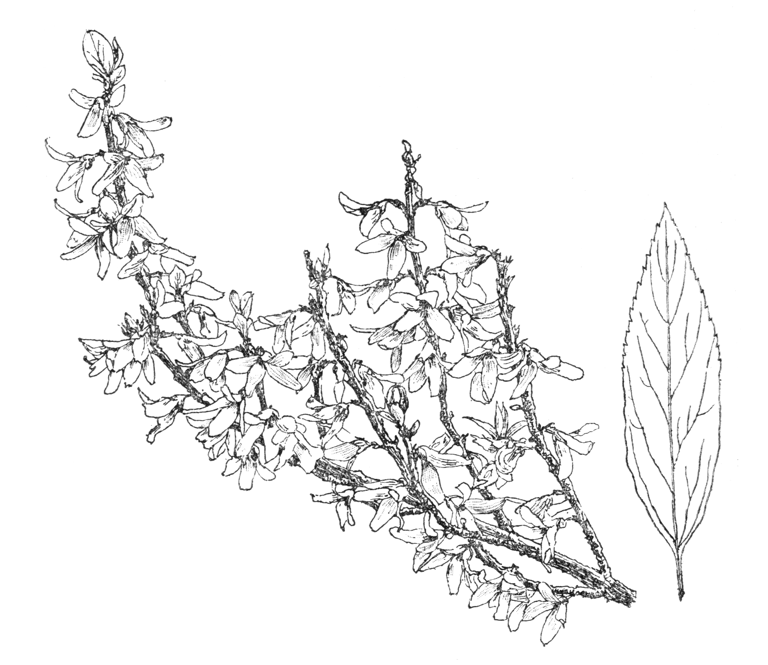A deciduous or partially evergreen shrub 5 to 8 ft high, with stiff, erect, somewhat four-angled branches with a greenish colouration even in the second year; pith lamellate. Leaves lance-shaped, 3 to 6 in. long, 3⁄4 to 11⁄2 in. wide, tapering at both ends, but more slenderly towards the pointed apex, toothed in the upper half or quite entire; stalk 1⁄4 to 1⁄2 in. long. Flowers bright yellow, 11⁄4 in. across, the four corolla-lobed narrow-oblong, 1⁄2 in. long. Calyx-lobes ovate, about half to three-quarters as long as the corolla-tube. Fruits broadly ovoid, beaked. Bot. Mag., t. 4587.
Native of China: introduced by Fortune in 1845, by means of a plant sent to the Horticultural Society, in whose garden it first flowered in 1847. It is not so fine a garden shrub as F. suspensa or the hybrids between it and that species (F. × intermedia) and is not so common as it was in the 19th century. It flowers one or two weeks later than F. suspensa, usually in April, and is sturdy enough to hold its branches erect. Its distinguishing characters are: the lamellate pith of the branches, the dark green lanceolate to oblong leaves toothed in the upper half and almost invariably undivided; and the short calyx, which is half as long as the corolla-tube.
F. viridissima was for long represented in cultivation by a clone with long-styled flowers. The garden clones of F. suspensa, on the other hand, were mainly short-styled. From this the false conclusion was drawn that these were specific characters. In fact, as Darwin surmised, the forsythias, like the common primrose, are heterostylous, some individuals of a species bearing only long-styled and others only short-styled flowers. But a clone, being descended vegetatively from a single individual, bears flowers of one kind only.
cv. ‘Bronxensis’. – A dwarf compact plant 8 to 12 in. high. Leaves ovate, 3⁄4 to 13⁄4 in. long, closely set on the stem. Flowers primrose-yellow. Award of Merit April 9, 1958. It was raised in the Boyce Thompson Arboretum from seeds received in 1928 from the Botanic Garden of the Imperial University of Tokyo, under the name F. viridissima var. koreana. Of three plants raised, two belonged to this variety. The third was a pygmy, of which propagating material was given to the New York Botanic Garden in the Bronx. It was named var. bronxensis in 1947 by T. H. Everett, the Curator, who at that time was unaware of the origin of the plant. Its history, as later ascertained by him, is given in Gard. Chron., Vol. 18 (1949), p. 90.
Many gardeners in Britain have found this variety shy-flowering, but it flowers well at the foot of a sunny wall in the Director’s garden at Kew, where its soft yellow flowers assort well with the slate-blue ones of Ceanothus rigidus.
var. koreana Rehd. F. koreana (Rehd.) Nakai – Leaves oblong-ovate or lanceolate, 2 to 43⁄4 in. long, toothed in the upper half or almost entire. Flowers slightly larger than in the typical state of the species and brighter yellow. Calyx more than half as long as the corolla-tube. Introduced from Korea to the Arnold Arboretum by Wilson in 1917 and to Kew in 1925. At Kew, the leaves do not colour in the autumn, as they are said to do in the USA.


